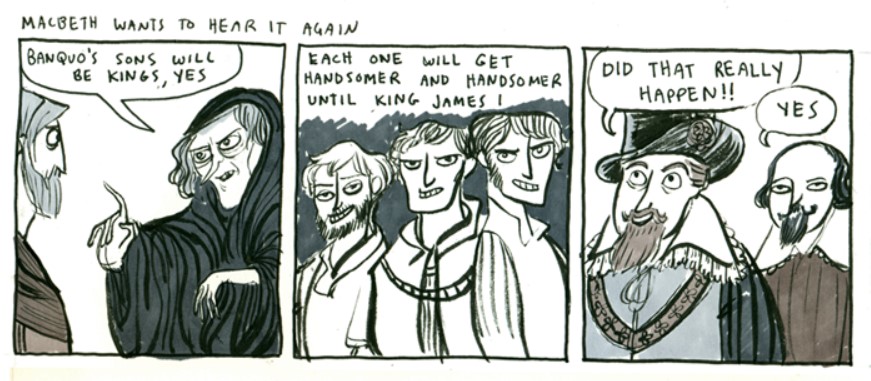This is not a glamourous post, but it does wrap up my thoughts after a long and arduous study, and also provide a full bibliography for anyone who wants to read further.
In this series, I examined three translations of Macbeth (based on Jakobson’s translation types) within the conceptual framework of adaptation. My goal was to trace how the translator/adapter’s interpretive intervention affects audience reception – both knowing and unknowing – and the creation of meaning. As I’ve said before, interlingual translation complicates audience knowledge, and it’s therefore unsurprising that, of the three texts, Felipe’s Castilian Macbeth o el asesino del sueño relies the least on prior audience knowledge. His aggravation of elements of Shakespeare’s Macbeth colors the reception of his play regardless of audience type. That said, these elements may carry greater significance when audiences experience the gossiping effect and thereby recognize them as departures from the source material. Conversely, the other two adaptations, intralingual and intersemiotic, make greater use of their palimpsestic doubleness. Morrissette’s Scotland, PA relies on the gossiping effect to create humor by contrasting Shakespeare’s story with the comedy’s updated diegesis. Sleep No More also benefits from its status as adaptation, but, rather than exploiting the tension between source and target, as Morrissette does, Sleep No More exploits source and target’s similarities. Punchdrunk’s performance allows Shakespeare’s Macbeth to help fill narrative gaps that arise from its alingual sign-system and structural peculiarities. Because Scotland, PA and Sleep No More are not interlingual, however, they do not signal their connection to the source as overtly as Felipe does, instead relying on more subtle, embedded links between source and target.
Of course the context and medium in which the texts exist must also be considered. With all three translations, the different intertexts (both literary and historical) create differently knowing audiences and increase the number of possible receptions available to spectators. What’s more, spectators will have different levels of familiarity with Macbeth itself despite and/or because of its canonical status. Those who possess overlapping knowledge of various intertexts, languages, and historical referents all at once will experience parallel and intersecting palimpsests that color their reception in even more complex constellations. Shifts in medium, genre, and form also differ, from stage play to film to immersive dance performance, and these constraints and advantages inform the adapter’s process and, consequently, audience reception. The effects of such formal elements are as important as the content they contain, and cannot be ignored when considering translation as adaptation and vice versa. Texts will ultimately produce an infinite number of audience responses, and I contend that any and all receptive concretizations will be, to echo Genette, self-enclosed, but incomplete. Still, our understanding of the text and its creative process undoubtedly deepens when we view translation as adaptation. To do so, we must embrace a text’s doubleness as part of the creation of meaning for those audiences who, rather than allowing the prior text to overpower or be effaced by its adaptation, can instead see both texts in one.
References
Brantley, Ben. “Shakespeare Slept Here, Albeit Fitfully.” The New York Times, April 13, 2011. https://www.nytimes.com/2011/04/14/theater/reviews/sleep-no-more-is-a-macbeth-in-a-hotel-review.html.
Cartelli, Thomas and Katherine Rowe. New Wave Shakespeare on Screen. Cambridge: Polity Press, 2007.
Díaz Cintas, Jorge and Aline Remael. Audiovisual Translation: Subtitling. New York: Routledge, 2014.
Disney. The Lion King. Written by Irene Mecchi, Jonathan Roberts, and Linda Wolverhampton. Directed by Roger Allers and Rob Minkoff. United States: Walt Disney Pictures, 1994.
Du Maurier, Daphne. Rebecca. London: Doubleday, 1938.
Ebert, Roger. “Scotland, Pa.” February 15, 2002. https://www.rogerebert.com/reviews/scotland-pa-2002.
Encyclopaedia Britannica. “Mandrake.” Chicago: Encyclopaedia Britannica, Inc., 2018. https://www.britannica.com/plant/mandrake-Mandragora-genus (Accessed 22 August 2020).
Felipe, León. Macbeth o el asesino del sueño: parafrásis de la tragedia de Shakespeare. Madrid: Visor Libros, 1954.
Genette, Gérard. Palimpsests: Literature in the Second Degree. Translated by Channa Newman and Claude Doubinsky. Lincoln: University of Nebraska Press, 1997.
Gleiberman, Owen. “Scotland, PA.” Entertainment Weekly, March 17, 2020. https://ew.com/article/2002/02/15/scotland-pa-2/.
Gonzalez, Ed. “Review: Scotland, PA.” Slant Magazine, February 4, 2002. https://www.slantmagazine.com/film/scotland-pa/.
Gregor, Keith. Shakespeare in the Spanish Theatre: 1772 to the Present. London: Continuum International, 2010.
Gregor, Keith. “Macbeth and Regimes of Reading in Francoist Spain.” Comparative Drama, Vol. 52, no. 1 & 2 (Spring and Summer 2018): 141-157. Project MUSE.
Gregor, Keith and Pujante, Ángel-Luis. Macbeth en España: las versiones neoclásicas. Murcia: Universidad de Murcia, 2011.
Hitchcock, Alfred (dir.). Rebecca. Screenplay by Robert E. Sherwood and Joan Harrison. Adaptation by Philip McDonald and Michael Hogan. United States: Selznick International Pictures, 1940.
Hitchcock, Alfred (dir.). Vertigo. Screenplay by Alec Coppel and Samuel Taylor. Based on D’entre les morts by Pierre Boileau and Pierre Ayraud, aka Thomas Narcejac. United States: Alfred J. Hitchcock Productions, 1958.
Hopkins, D.J. “Sleep No More (review).” Theatre Journal, Vol 62, no. 2 (May 2012): 269-271. Baltimore: Johns Hopkins University Press.
Hutcheon, Linda. A Theory of Adaptation. New York: Routledge, 2006.
Jakobson, Roman, 1959. “On Linguistic Aspects of Translation.” In The Translation Studies Reader, Second Edition. Edited by Lawrence Venuti, 126-131. London: Routledge, 2012.
Krebs, Katja. “Introductio n.” In Translation and Adaptation in Theatre and Film, edited by Katja Krebs. New York: Routledge, 2014.
Macbeth: an original ballet. Created by Francis Patrelle. Kaye Playhouse, Hunter College, New York City, 2016.
Marco, Jorge. Guerrilleros y vecinos en armas: identidades y culturas de la resistencia antifranquista. Granada: Editorial Comares, 2012.
McCullah, Karen and Kirsten Smith. 10 Things I Hate About You. Directed by Gil Junger. United States: Touchstone Pictures, 1999.
Morrissette, Billy. Scotland, PA. Written and directed by Billy Morrissette. United States: Lot 47 Films, 2001.
OED Online. “palimpsest, n.”. Oxford University Press, 1989. https://www.oed.com/view/Entry/137577?rskey=jiPFhG&result=1&isAdvanced=false (accessed August 22, 2020).
OED Online. “paraphrase, n.”. Oxford University Press, 2020. https://www.oed.com/oed2/00169695 (accessed August 26, 2020).
Pavis, Patrice. Theatre at the Crossroads of Culture. Translated by Loren Kruger. London: Routledge, 1992.
Pujante, Ángel-Luis. Shakespeare llega a España: Ilustración y romanticismo. Madrid: A. Machado Libros, 2019.
Rosenblatt, Louise. The Reader, the Text, the Poem: The Transactional Theory of the Literary Work. Carbondale: Southern Illinois University Press, 1978.
Scotland, PA. Roundabout Theatre Company. Book by Michael Mitnick. Music and Lyrics by Adam Gwon. Directed by Lonny Price. Laura Pels Theatre, New York City, 2019.
Shakespeare, William. Macbeth, edited by Sandra Clark and Pamela Mason. London: Bloomsbury, Arden Shakespeare,
2015.
Shakespeare, William. Macbeth. Translated by José García de Villalta as Macbeth: drama histórico en cinco actos. Madrid: José María Republlés, 1838.
Shakespeare, William. Macbeth. Translated by Nicolás González Ruiz. Madrid: Editorial Mediterraneo, 1944.
Shakespeare, William. Macbeth. Translated by Manuel Ángel Conejero and the Instituto Shakespeare. Madrid: Catedra, 1987.
Sleep No More. Performed by Punchdrunk. Directed by Felix Barrett and Maxine Doyle. McKittrick Hotel, New York City, 2011.
Ubersfeld, Anne. Reading Theatre. Translated by Frank Collins. Toronto: University of Toronto Press, 1999.
United States Copyright Office. “Copyright in Derivative Works and Compilations (Circular 14).” Accessed August 31 2020.
https://www.copyright.gov/circs/circ14.pdf.
Van Sant, Gus. My Own Private Idaho. Written and directed by Gus Van Sant. United States: Fine Line Features, 1991.
Zaro, Juan Jesús. Shakespeare y sus traductores: Análisis crítico de siete traducciones españolas de obras de Shakespeare. Bern: Peter Lang, 2007.
Feature image by Kate Beaton.

